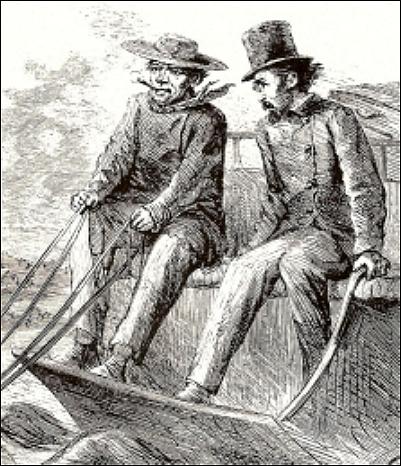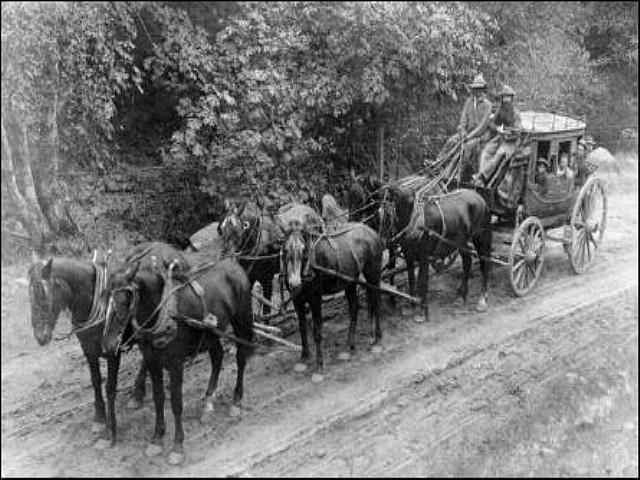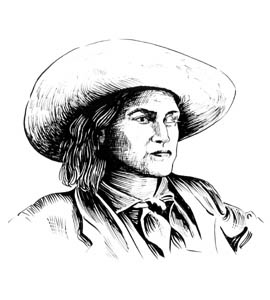March is Women's History Month so here's one of my favorites...
Stagecoach Charley
veryone knew that "Mountain Charley" Parkhurst was one of Wells Fargo's most colorful stagecoach drivers. But until the day he died, no one knew his secret. Weighing close to 175 pounds and around five feet seven inches tall, he had broad shoulders and was beardless. Charley had big arms, a rather sharp, high-pitched voice and early on had learned to hold his own. He preferred sleeping in stables with the horses rather than going out with the boys. A patch over one eye was evidence of an encounter with a horse that obviously didn’t realize who it was dealing with; but the other gray eye, sharp as a hawk’s, squinted out from under a battered hat that shaded a leathery, brown face. He smoked cigars, chewed tobacco, drank moderately, played cards, and shook dice for cigars and drinks; always cheerful and agreeable, but always reticent about personal matters. Those who rode with Charley said he was as skillful, as resourceful and as hard-boiled as any driver in the Sierras. His secret...Charley was a woman.
Mountain Charley began life as Charlotte Darkey Parkhurst, born in Lebanon, New Hampshire, during the year of 1812. Legend has it that she was abandoned by her parents and placed in an orphanage from which she later escaped disguised in boy's clothing. Dressed as a male to make her escape from the orphanage, she probably never again dressed as a woman because the disguise worked so well. Employment for a young girl in those times was out of the question, but boys could apprentice themselves in a business, learn the trade and eventually earn a living at it. Charlotte found work as Charley in a livery stable own by Ebenezer Balch in Worchester, Massachusetts, where the runaway earned bed and board cleaning stalls, washing carriages and scrubbing floors; anxious to learn all she could about horses, the stable hand grew to understand them by carefully watching every move made by the stage drivers, who drove Concords [stagecoaches] into Worchester. Before long Charlie was handling teams, and from there it was a natural progression to becoming a stagecoach driver. The other drivers may have wondered why the new fellow didn’t mingle very much with them and preferred to sleep in the stable with the horses, but they evidently accepted the wiry driver who claimed to get along better with horses than with people. Ebenezer Balch found promise in his young protégé and soon taught Charley the art of driving, first two-in-hand, then four-in-hand, and later six-in-hand horse teams. When Balch bought the Franklin House and the What Cheer Stables, Charley went with him to Providence, Rhode Island, where Parkhurst's reputation was made. In time, Charley Parkhurst became known as one of the best coachmen on the eastern seaboard, and coaches were often hired only on condition that Charley drive. At this time, Charley's favorite team was the best in the stables, six perfectly matched grays.
Then came the first threat of exposure. One January, at a dance in Pawtuxet, while waiting outside in the cold for the passengers to return, Charley's hands froze. Unable to drive, Parkhurst had to call upon another driver, Liberty Childs, to take over the coach. Liberty Childs is described by MacDonald as Charley's proud friend. Whether due to the shame of asking for help or the joshing that came from needing it, shortly thereafter Charley left New England and relocated in Georgia, where the young whip enjoyed a reputation of sure-handed driving. Once in Georgia, Charley drove for Jim Birch, who was getting ready to come west and operate the California Stage Company. Charley came along, saying "I aim to be the best damn driver in California."
Parkhurst arrived in San Francisco in 1851. Nearly forty years old, Charley walked off the gang plank at the pier, wearing gloves to hide a pair of woman's small hands and a pleated shirt to hide a woman's figure. The trip had been an uneventful one, except for Charley's presence on board. The curious figure attracted several admirers. On board the steamer R.B. Forbes from Boston to Panama, one John Morton of Morton Draying and Warehouse Company of San Francisco pronounced Parkhurst, "an agreeable 'companion de voyage' who had been a stage driver in the East and who came to California to drive a stage between Stockton and Mariposa." Even more telling was the comment made by European traveler John Charles Duchow while traveling with Charley in Panama. Duchow later wrote in his journal, "He calls himself Charles Clifton but passengers on board call him 'Thunderbolt.' He says the reason for passing under an assumed name was that he was an important witness in a case and wishing to have nothing to do with it, adopted a false name to get out of the way. He told us that he's married to a Boston merchant where he is keeper of the American's house. . .. In short, he is a very queer fellow indeed!"
Whatever the reason, Charley found a home in California. The early 1850s were still bustling with gold fever, and Charley was a part of the excitement, driving stage coaches through the wildest boom towns of the Gold Country -- Rough and Ready, Grass Valley, and Placerville. Charley tried new routes from Oakland to San Juan Bautista, and by 1856, Parkhurst lived at Searsville in San Mateo City. Charlie came west seeking her own fortune in the Gold Rush. She spent the next 15 years driving stages in both California and western Nevada. Over the years, her reputation as an expert "whip" grew legendary. Charley handled all six reins plus the whip with an easy dexterity. From 15 feet away she could slice open the end of an envelope or cut a cigar out of a man's mouth. Parkhurst smoked cigars, chewed wads of tobacco, fought and drank with the best of them, and exuded supreme confidence behind the reins. From 1852 on, she was driving stagecoaches on nearly every road in the Mother Lode, with the reputation of being one of the safest and fastest drivers in California. According to one source, ". . . in more than twenty years no highwayman had dared to hold up a stagecoach with Charlie Parkhurst on the box, for the first two who tried it had been shot dead in their tracks."
During this time, Charley received an injury and a celebrated nickname of "Cock-eyed Charley." She was kicked in the face by a horse she was shoeing. The accident cost her an eye and ever after she wore a black patch over it, earning her the sobriquet of 'One-Eyed Charley'." Lee adds, "From then on people called her 'One-Eyed Charley,' but not in her presence, of course." There are various stories explaining how Charley lost the left eye, but all sources agree that the horse that caused the mishap was Charley's lead horse Pete. The bland episode of the horse kicking Charley while being shod turns lurid in one retelling that had a nail misfire and take out the eye. Another more romantic explanation for Pete's behavior is a rattlesnake. According to Patty Stoker, the horses became skittish and Charley had stopped the coach to soothe the lead horse Pete, when a rattler shook its tail, frightening Pete and causing him to kick Charley. This injury did not end Charley's love of horses or desire to ride the western stage. In the 1860s, Charley was back driving the stage from Tahoe to Placerville and Sacramento to Mariposa. A respected driver throughout Northern California, Charley was entrusted with special missions by Wells Fargo. According to Mabel Rowe Curtis, "Such was Charley's fearlessness and attention to duty that Wells Fargo once sent him to New York with a quantity of gold which he delivered safely."
Charlie worked for the Pioneer Line, which was taken over by Wells Fargo in 1866 when the company bought out Ben Holliday. The Pioneer Line provided service between San Jose and Santa Cruz, and was the rival company that engaged Charley McKiernan in the great price war, so feelings occasionally ran high between drivers on the two lines. Charlie’s route out of Los Gatos went by way of Lexington, where driver and passengers undoubtedly stopped to refresh themselves at Sarah Paddock’s Lexington House before the perilous ordeal ahead. Two horses were added to the four-horse team for the long haul up to the summit. Avoiding the toll gate to Mountain Charley Road at Patchen, the stagecoach proceeded straight ahead up to the Schultheis ranch, then turned southeast down the ridge to pick up the Soquel Road leading to the coast.
Stagecoach companies were big business during the Comstock's heady years of massive silver production. One of the most successful lines was the Pioneer Stage Company. The Pioneer Stage route followed the old trail between Placerville, California, over the Sierra past South Lake Tahoe, to Genoa, Nevada. The company maintained twelve superb Concord Coaches with six horses to each stage. Business was brisk. On average, more than 100 passengers used the line daily to reach Virginia City from California. Besides passengers, the stages hauled gold and silver bullion as well as mine company payrolls. Stage robbery was a constant danger in the days before law and order arrived in the Wild West. Bandits employed many strategies to ambush a stagecoach. The most common method was for the highway robbers to hide behind a thicket of trees or lay flat on the ground. When the stage approached, the crooks would jump to their feet with their guns drawn. The gang was usually after the Wells Fargo box with its valuable contents. Passengers were seldom hurt, but they were often relieved of their cash, watches and jewelry.
During the peak of the Gold Rush, bands of surly highwaymen stalked the roads. These outlaws would level their shotguns at the drivers and shout, "Throw down the gold box!" Charley Parkhurst had no patience for the crooks despite their demands and threatening gestures. One of the most notorious road agents was nicknamed "Sugarfoot" When he and his gang accosted Charley's stage, it was the last robbery the thief ever attempted. Charley cracked her whip defiantly and the horses bolted. Charley then grabbed her six-shooter, and with bullets blazing, raced away without loss or injury. Sugarfoot, however, was later found dead with a fatal bullet wound in his stomach. In appreciation of her bravery, Wells Fargo gave Parkhurst a large watch and chain made of solid gold that Charley carried with pride.
Accidents were not uncommon on the narrow mountain roads. Coaches were blown off the road during winter storms, dragged by runaway teams, forcing the passengers to jump for their lives, and horses were spooked by wild pigs running across their path. One time, as Charley braked her stagecoach down Carson Pass, the lead horses stumbled off the road. Charley bit down hard on her two-bit cigar and used all her strength to stop the run-away coach, but the terrain was too rough. The wooden wheels nearly splintered when the stage struck the rocky embankment. A wrenching jolt threw Charley from the rig, but she hung on tight to the reins. The horses dragged Charley along on her stomach, but she managed to steer the frightened horses back onto the road and pull them to a halt. Charley had saved all her passengers and was now a bona fide hero.
In 1862, Charley relocated to work as a stage driver on the route from Santa Cruz to San Juan Bautista. A few years later, tired of the demanding job of controlling a half dozen spirited horses on narrow, winding roads, Parkhurst opened her own stage station. The passengers and mail were getting through to Santa Cruz, and Charlie, despite the ravages of rheumatism (a common problem among drivers exposed to years of bad weather) continued to drive until the railroad began pushing into the mountains. Finally, in the late 1860s, Charley retired from riding the stage. She commented, "I'm no better now than when I commenced. Pay's small and work's heavy. I'm getting old. Rheumatism in my bones -- nobody to look out for old used-up stage drivers. I'll kick the bucket one of these days and that'll be the last of old Charley." She later sold the business and retired to a cabin on Bean Creek (near Soquel, California) to raise cattle, farm and haul freight for neighbors with partner Frank Woodward, a bachelor.
Ulysses S. Grant was running for President in 1868 and Charlie registered to vote. (Whatever the reasons that caused Charley Parkhurst to pursue this unique career, the remains of this famous stage driver were buried in Watsonville's Pioneer-Odd Fellows cemetery. In 1954, after the old cemetery had grown into neglect, the Pajaro Valley Historical Association discovered the Parkhurst plot, and Charley's remains were removed and reburied with an historical marker erected in 1955." The bronze plaque was erected in the town of Soquel, where the duly registered Charley [sic] Parkhurst had voted in November 1868, proclaiming that it marked the site where the first woman cast a ballot in a presidential election"....long before the passage of the 19th amendment in 1920 allowed women to vote.)
The years slipped by and then Charley died on December 29, 1879, at the age of 67, from cancer of the tongue and rheumatism. Legend has it that the old stagecoach driver died alone, but actually Charley was tended by the Harmons, who were neighbors, and by Frank Woodward her former partner. George Harmon related that his father came close several times to being told the secret of Parkhurst's life, but each time the old-timer drew Harmon close to the sickbed, the invalid would wave him away, saying it would keep. And so the secret was kept until Charley's death. The disguise had held, but now the truth was out. When the neighbors came to the cabin to lay out the body for burial, they discovered that the renowned stagecoach driver was a woman. Even Frank Woodward, the business partner and longtime companion, seemed shocked to learn Charley's true biological sex. Reports were that Woodward "waxed profane to the extreme when he learned of the deception that had been practiced on him so many years."
A few days later, the Sacramento Daily Bee published her obituary. It read; "On Sunday last, there died a person known as Charley Parkhurst, who was well-known to old residents as a stage driver. He was in early days accounted one of the most expert manipulators of the reins who ever sat on the box of a coach. It was discovered when friendly hands were preparing him for his final rest, that Charley Parkhurst was unmistakably a well-endowed female, but further examination revealed that Charley had given birth to a child." Immediately, some gentlemen of the press proclaimed Charley a hermaphrodite, but the coroner's findings disagreed. The Watsonville Pajaronian wrote on January 8, 1880, "Rumors that in early years she loved not wisely, but too well, have been numerous and from the reports of those who saw her body, these rumors receive some color of truth. It is generally believed that she had been a mother and that from that event, dated her strange career."People that had known "Charley" for a quarter of a century were stunned that her real name was Charlotte Parkhurst, who never volunteered clues to her past. Loose fitting men's clothing hid her femininity and after a horse kicked her, an eye patch over one eye helped conceal her face. In the town where Charley first found fame, the Providence Journal wrote, "Charley Parkhurst was one of this city's finest stage drivers. The only people who have any occasion to be disturbed by the career of Charley are the gentlemen who have so much to say about 'women's sphere' and the 'weaker vessel'." She was in her day one of the most dexterous and celebrated of the famous California drivers ranking with Foss, Hank Monk, and George Gordon, and it was an honor to be striven for to occupy the spare end of the driver's seat when the fearless Charley Parkhurst held the reins of a four-or six-in hand. . .


